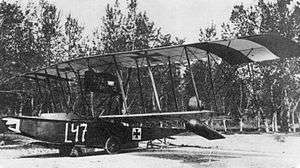Lohner L
|} The Lohner L was a reconnaissance flying boat produced in Austria-Hungary during World War I. It was a two-bay sesquiplane of typical configuration for the flying boats of the day, with its pusher engine mounted on struts in the interplane gap. The pilot and observer sat side by side in an open cockpit, and both the upper and lower sets of wings featured sweepback.
Development
The design was essentially a more powerful version of the Lohner E, and became highly influential. Apart from licensed production by UFAG, the L provided the basis for designs by other major manufacturers. In Germany, Hansa-Brandenburg manufactured a modified version of it as their first flying boat, the FB, and in Italy, a captured example was used as a pattern aircraft by Macchi, who produced it as the L.1. In turn, the L.1 would provide the foundation for a large number of Macchi designs over the coming years.
The captured aircraft (serial L.40) was taken intact near the naval air station of Porto Corsini. The captured flying boat was copied by Macchi-Nieuport and the L.1 was built within a month. The L.1s were delivered to Italian maritime reconnaissance and bombing units based on the Adriatic. An improved version was developed as the Macchi L.2
A restored example of an Austro-Hungarian Lohner L (serial L.127) is preserved at the Italian Air Force Museum at Vigna di Valle.
Operational history
Lohner seaplanes saw extensive use before and during World War I, and those aircraft that survived the war served for several years. Some important and interesting events are related, such as:
- Immediately after the declaration of war by Austria-Hungary on Serbia and Montenegro, from 28 July 1914 to 2 August 1914, Lohner L seaplanes from Kumbor patrolled and photographed the Montenegrin artillery positions, representing the first use of aircraft in World War I.
- On 16 September 1915 Lohner L 132 piloted by a Lieutenant Commander Dimitrije Konjović and Lohner L 135 piloted by Walter Železni, on regular reconnaissance missions off Cattaro found the French Brumaire-class submarine Foucault and attacked it with bombs. The submarine was damaged in the attack and was abandoned by her crew. One Lohner flying boat landed at sea, captured two French officers and transported them to Kumbor. The other members of the crew were rescued by an Austro-Hungarian torpedo boat. This was the first sinking of a submarine from the air in the history of aviation.
Variants
- Lohner L
- Lohner R - Photo-reconnaissance version
- Lohner S - Trainer version
- Macchi L.1 - with Fiat machine gun and Isotta-Fraschini V.4a engine (14 built)
Operators
- Regia Marina (Macchi L.1)
- Yugoslav Royal Navy - 4 aircraft Lohner TL
Specifications (Lohner L)
.jpg)
General characteristics
- Crew: two, pilot and observer
- Length: 10.26 m (33 ft 8 in)
- Wingspan: 16.2 m (53 ft 2 in)
- Height: 3.85 m (12 ft 8 in)
- Wing area: 53 m2 (570 sq ft)
- Empty weight: 1,150 kg (2,535 lb)
- Gross weight: 1,700 kg (3,748 lb)
- Powerplant: 1 × Austro-Daimler 6 6-cyl. water-cooled in-line piston engine, 120 kW (160 hp)
Performance
- Maximum speed: 105 km/h (65 mph; 57 kn)
- Range: 600 km (373 mi; 324 nmi)
- Service ceiling: 2,500 m (8,200 ft)
Armament
- Guns: 1 × trainable machine gun for observer
- Bombs: 200 kg (440 lb) of bombs
Notes
References
| Lohner L | |
|---|---|
 | |
| Role | Reconnaissance flying boat |
| National origin | Austria-Hungary |
| Manufacturer | Lohner, UFAG, Hansa-Brandenburg, Macchi |
| First flight | ca. 1915 |
| Number built | >100 |
| Wikimedia Commons has media related to Lohner L. |
- Taylor, Michael J. H. (1989). Jane's Encyclopedia of Aviation. London: Studio Editions. p. 611.
- World Aircraft Information Files. London: Bright Star Publishing. pp. File 900 Sheet 20.
- The Illustrated Encyclopedia of Aircraft (Part Work 1982-1985). Orbis Publishing. p. 2392.
- Јанић, Чедомир (2003). Век авијације - [илустрована хронологија] (in Serbian). Беочин: Ефект 1. COBISS 110428172.
- Italian Air Force Museum page on Lohner L